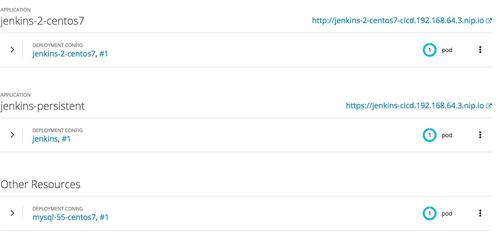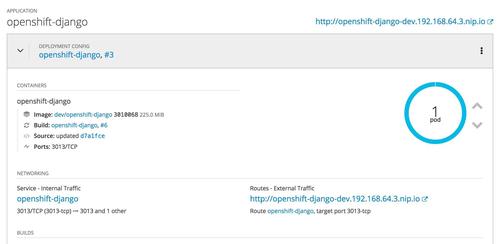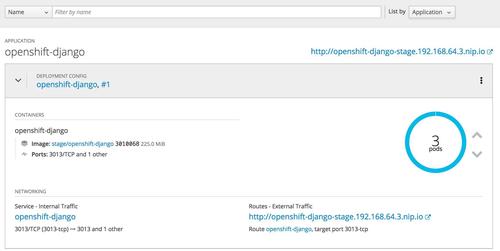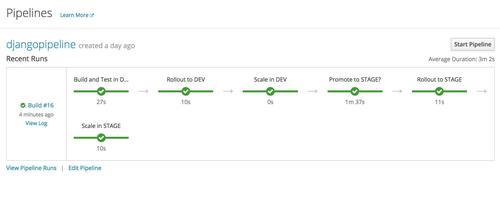Deploy Django to OpenShift Using Jenkins Pipeline(CI/CD)
Jul 22, 2018 · 4 Min Read · 3 Likes · 5 Comments
Using Jenkins pipeline, you can easily automate your deployments in OpenShift. In this post, we are going to use this powerful tool to deploy a Django project. But before we start, one thing I need to mention is that, this project has been tested on in Minishift 1.2.0, OpenShift v3.9.0 and Kubernetes v1.9.1. So without further adieu, let us begin.
Source code
You can find the source code for a this project here: https://github.com/ruddra/openshift-django
Pipeline execution steps
On every pipeline execution, the code goes through the following steps:
- First, jenkins will check if build configuration for this repo exists in
devproject. - If not, then it will create new app using the templates provided in code.
- Then, it will build and test the code
- After successful build, it will deploy the image to
devproject. - Then it will prompt if it will deploy the code to stage. If yes, then it will proceed to next step, else it will abort.
- It will push the
devimage tostageand tag it aspromoteToQA. - This image will be deployed to
stageproject and will be scaled to 3.
Automated deploy on minishift
Go to scripts directory and run ./setup.sh
Manual deploy on minishift
First, run minishift using minishift start memory=4000. Then, run the following commands to create projects in OpenShift.
# Create Projects
oc new-project dev --display-name="Tasks - Dev"
oc new-project stage --display-name="Tasks - Stage"
oc new-project cicd --display-name="CI/CD"
Install Jenkins in cicd by running
oc project cicd
oc new-app openshift/jenkins-2-centos7
Now, give permission to Jenkins to modify in dev and stage project.
oc policy add-role-to-user edit system:serviceaccount:cicd:jenkins -n dev
oc policy add-role-to-user edit system:serviceaccount:cicd:jenkins -n stage
Deploy the MySQL in cicd project by loading MySQL template like this:
oc new-app -f .openshift/templates/mysql-template.yaml
It will create the mysql server. Please keep in mind that, this MySQL will be available in 172.30.0.30. This configurations in defined in Service configuration section of the template
So, we are almost ready. Now please load the pipeline using:
oc new-app -f .openshift/pipelines/openshift-django-pipeline.yaml
Now you will be able to see the pipeline in Console > CI/CD > Build > Pipelines. You can run it from there or from CLI like:
oc start-build djangopipeline
To implement webhooks, you can look into this project.
Screenshots
Pipeline execustion looks like this in Blue Ocean:

Stage View in Jenkins looks like this:

In CI/CD project of OpenShift:

In Dev project of OpenShift:

In Stage project of OpenShift:

After Pipeline execution, it should look like this:

Deploy your project: pre-requisite
- Have a Django Project with Docker to deploy it.
- Have minishift installed in your local machine.
- Give it 4GB memory.
- If you can pull python, jenkins-2-centos7, mysql-55-centos7 images beforehand using
docker pull <image name>, it would make the deployment much more faster.
deploy your project: modify pipeline
You can use this Pipeline to deploy your own project with this minimal changes:
- Go to Pipeline template at in my github repository: OR Take this pipeline:
def openshiftDjangoRepo="https://raw.githubusercontent.com/ruddra/openshift-django/develop/.openshift/templates/openshift-django-template.yaml"
def stageTag="promoteToQA"
def DEV_PROJECT="dev"
def STAGE_PROJECT="stage"
def templateName="openshift-django"
pipeline{
agent { label ""}
stages{
stage('Create in DEV') {
when {
expression {
openshift.withCluster() {
openshift.withProject(DEV_PROJECT) {
echo "checking openshift django exists in DEV"
return !openshift.selector("bc", "${templateName}").exists();
}
}
}
}
steps {
script {
openshift.withCluster() {
openshift.withProject(DEV_PROJECT) {
openshift.newApp(openshiftDjangoRepo).narrow("svc").expose();
}
}
}
}
}
stage('Build and Test in DEV'){
steps {
script {
openshiftBuild(namespace: "${DEV_PROJECT}", buildConfig: "${templateName}", showBuildLogs: 'true', waitTime: "600000")
}
}
}
stage('Rollout to DEV') {
steps {
script {
openshiftDeploy(namespace: "${DEV_PROJECT}", deploymentConfig: "${templateName}", waitTime: "600000")
}
}
}
stage('Scale in DEV') {
steps {
script {
openshiftScale(namespace: "${DEV_PROJECT}", deploymentConfig: "${templateName}", replicaCount: '1')
}
}
}
stage('Promote to STAGE?') {
steps {
timeout(time:15, unit:'MINUTES') {
input message: "Promote to STAGE?", ok: "Promote"
}
script {
openshift.withCluster() {
openshift.tag("${DEV_PROJECT}/${templateName}:latest", "${STAGE_PROJECT}/${templateName}:${stageTag}")
}
}
}
}
stage('Rollout to STAGE') {
steps {
script {
openshift.withCluster() {
openshift.withProject(STAGE_PROJECT) {
if (openshift.selector('dc', "${templateName}").exists()) {
openshift.selector('dc', "${templateName}").delete()
openshift.selector('svc', "${templateName}").delete()
openshift.selector('route', "${templateName}").delete()
}
openshift.newApp("${templateName}:${stageTag}").narrow("svc").expose()
}
}
}
}
}
stage('Scale in STAGE') {
steps {
script {
openshiftScale(namespace: "${STAGE_PROJECT}", deploymentConfig: "${templateName}", replicaCount: '3')
}
}
}
}
}
- Edit this line in the template:Change the url to either your repository link like
def openshiftDjangoRepo="https://raw.githubusercontent.com/ruddra/openshift-django/master/.openshift/templates/openshift-django.yaml"https://github.com/ruddra/openshift-django - Change the template name in there as well:
def templateName="openshift-django"
Advanced implementation
In this post, we have deployed our application by using only OpenShift APIs in Jenkins Plugin. If you want more advanced implementation, like having Jenkins do build, testing, store test results etc with more advanced pipeline, then please look into these posts:
- Deploy A Python App to OpenShift: Planning and Preparations
- Writing Jenkins Pipeline For OpenShift Deployment
- Automated Deployment to OpenShift Using Jenkins and Webhook
Thanks for reading. Cheers!!
Last updated: May 04, 2025


Hi, Thank you for this blog post. Could you please confirm is this method possible on FREE Plan of open shift? I get a error message saying build strategy Docker is not allowed.
Well, I also faced the same issue. Its related role management of Openshift Online. Maybe you can look into this: https://bugzilla.redhat.com/show_bug.cgi?id=1336345
Thank you for the blog post actually ran into the allowed_hosts error and luckily you covered it in your post!
Hi, It was really good. Can you please post like this for springboot microservice application with secrets & configmaps included in the template and CI/CD pipeline with jenkins.
Hi @praveenlnx, There is a good tutorial by redhat available here: https://blog.openshift.com/cicd-with-openshift/ This is the one I used for learning and used the knowledge to implement CI/CD for Django. You can look into this as well.